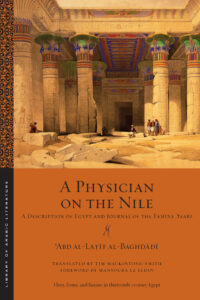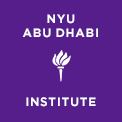 A Physician on the Nile begins as a description of everyday life in Egypt at the turn of the seventh/thirteenth century, before becoming a harrowing account of famine and pestilence. In this interview, the first of a two-part series, translator Tim Mackintosh-Smith sits down with A. J. Naddaff to discuss the essence of the book, his work as a translator and author, and his experience living in Sanaa, Yemen.
A Physician on the Nile begins as a description of everyday life in Egypt at the turn of the seventh/thirteenth century, before becoming a harrowing account of famine and pestilence. In this interview, the first of a two-part series, translator Tim Mackintosh-Smith sits down with A. J. Naddaff to discuss the essence of the book, his work as a translator and author, and his experience living in Sanaa, Yemen.
You’ve translated for a long time now, including a previous text titled Two Arabic Travel Books for LAL. Every translator of course remembers the first text they worked on. What was yours?
I’m taken back to Mr. Gillette’s Latin class circa 1971-72. I remember being given a Latin prose—these little paragraphs taken from Caesar that we had to translate into English. And I can remember absolutely loving that. As for Arabic, the first solid translation that came out was “City of Divine and Earthly Joys: The Description of Sanaa” in 2001. It is literally a description of Sanaa in the eighteenth century, a beautiful crystalline description of the city. That piece is still very much alive in my mind because Sanaa is really my home, and I am not there at the moment.
Although you’ve been based in the Yemeni capital, Sanaa, for four decades, you’ve also gotten to know Cairo. The first part made me miss Cairo and the food and the second part, as we’ll get into, was quite gruesome to say the least. How did this book make you think of Cairo?
One of the joint dedicatees is Habiba, an old friend of mine who introduced me to Cairo. She is a great cook and is born and brought up in what they call the city of the dead. She has a house where on the rooftop you can literally reach out and almost touch the tomb of Qaytbay. It is in the densest part of Cairo, where the living and the dead famously live cheek by jowl. She came from this house that was full of her sisters, and they were always chopping things, making mulukhiyyah for example, and she would say ‘let’s go down the road to al-Hussein and have pigeon.’ I often also eat fasīkh, this ancient Egyptian fish, with her. The kind of food and the people and the great patchwork of the living and the dead which is Cairo all come back strongly from ʿAbd al-Laṭīf’s book.
The Arabic title of A Physician on the Nile can be literally translated as The Book of Edification and Admonition: Things Eye-Witnessed and Events Personally Observed in the Land of Egypt. I’m curious about the word choice of “eye-witnessed” and “personally observed.”
When he uses those past participle passives, he is talking about observing firsthand. To get inside his mind, he is thinking of it as a scientific text in which the idea of bayān, actually going to look at things, is absolutely paramount. This whole business of why he talks about so much of things like aḥwāl, which we often think of as circumstances, but it seems to be his word for what Aristotle would say is phenomena, the outward appearances of things. The book is all about observing, witnessing, reporting. And of course, taking what you see and forming hypotheses. It is a work of empiricism. As a good Muslim, he would have always had this Quranic injunction: “Why have they not then journeyed in the land and seen the end of those who died before them?”
The fact that this book was addressed to/written for the Caliph brings a whole additional dimension to understanding the text.
Absolutely. ʿAbd al-Laṭīf obviously came from Baghdad, as he is called al-Baghdādī. I suspect he had a strange relationship with his ancestral city. Ibn Jubayr described the city as having “nothing left of it but its famous name,” when he visited when ʿAbd al-Laṭīf was a student there. At the same time, you have the Caliph al-Nasr who, during ʿAbd al-Laṭīf’s youth, was reviving the idea of the caliphate as the supreme governorship of Islam. So by going out and reporting back to the caliph, which is ʿAbd al-Laṭīf’s stated purpose in writing this little book, he is actually serving him. By implication, by serving the caliph he is serving God because the caliph is the representative of God on earth. So I think this is why I call it an act of faith.
 In the 1990s you spent most of your time writing a book about Yemen that won awards and was classified as travel literature, Yemen: Travels in Dictionaryland. You refused that categorization but also went on to write true travel or topographical literature, including a trilogy on Ibn Battutah. Can A Physician on the Nile be classified as travel literature?
In the 1990s you spent most of your time writing a book about Yemen that won awards and was classified as travel literature, Yemen: Travels in Dictionaryland. You refused that categorization but also went on to write true travel or topographical literature, including a trilogy on Ibn Battutah. Can A Physician on the Nile be classified as travel literature?
I suppose you could classify it as a riḥlah. It is a bit of thing of Western academics to want to classify books. ʿAbd al-Laṭīf’s book is what it is: it’s a bit of a travel book, a bit of a history. I think he thought of it as a report for the caliph, and as ʿilm, or science, and all its implications. It has a literary kind of feel to it because it is written to the caliph so it has to be reasonably well-written, but it is not high literature. He hardly indulges in sajʿ (rhymed prose) or anything else.
One thing we can say, in the words of Ibn Abī Usaybi‘ah, a contemporary biographer, is that it’s a book that astonishes the intellect. What’s most mind-blowing to you about it?
It’s mainly the second part of the book. You know, he called it the book of edification, giving useful information, and the book of admonition, looking at something and drawing wisdom from it for self-improvement morally and in other ways.
Of course, in the case of A Physician on the Nile it really is mind-blowing because he has these first-hand accounts of the most horrific scenes of cannibalism, gnawing hunger which causes people to commit murder and to eat corpses of dead relatives. There is a scene where a woman is eating her husband’s thigh and she says, “It’s alright, he is my husband.” I suppose by calling this an admonition he is saying we should read this and watch what is happening to a society that is falling apart. That’s really my take on it.

Sanaa, Yemen, by Rod Waddington, via Wikimedia Commons (CC BY-SA 2.0)
ʿAbd al-Laṭīf recounts with a focus on the victims, on the destitute or the wretched of the earth. That’s something you don’t find too often in historical works or even other literary works, is it?
Oh absolutely, and you know I realized as I was working on the translation in Sanaa in the thick of the war–and I think I say in the introduction–that it is obvious when missiles are falling because the windows shatter and the house shakes. But of course, many of the victims of that war have been people who’ve died of starvation, and very often small children or older people who have felt it beneath them to go out and beg. Hunger, famine is the silent killer there and it’s not obvious. It tends to affect the poor. And I realize, I’m like most historians, I kind of don’t know the kind of people who die from hunger and therefore I tend not to see them. If you do a survey about the famine in Egypt, as al-Maqrizī did a few hundred years after ʿAbd al-Laṭīf, he mentions so many people died but the actual hands-on horror of watching instances of cannibalism isn’t there in most—if not all—accounts.
It seems like strangely your experience working on this book in the middle of Yemen’s civil war might have brought a sort of immediacy to the text, experiencing history in situ.
That moment during the war in Yemen was rather like being pressed up very close against the cinema screen. It’s hard to make out what’s going on because you’re just too close to it. And I think, you know, it is a strange way of reaching ʿAbd al-Laṭīf, writing about the horrors of some of it, the pestilence and the earthquake as well as he does. It was a kind of relief because there’s somebody else actually experiencing at very close quarters rather horrible happenings—very horrible happenings. I actually did have a sort of fellow feeling with him.
 You were also working on your massive tour de force book on Arab history titled Arabs: A 3,000-Year History. How did you balance between writing Arabs and translating A Physician on the Nile at the same time? What was your routine like?
You were also working on your massive tour de force book on Arab history titled Arabs: A 3,000-Year History. How did you balance between writing Arabs and translating A Physician on the Nile at the same time? What was your routine like?
I can hardly remember. I don’t know how I did it because, I don’t know, it’s kind of almost a blank to remember. I know I was very, very disciplined. I’ve got one of those tower house kind of things in Sanaa and all of the time I wasn’t sleeping I spent in a very small room about five feet by eleven working on these two books. And I just work, work, and work and have sort of power nap and continue.
I’m just curious, was it all digital PDFs that you worked with for Arabs? Or were they from your library or what?
It’s kind of the fruit of reading after many decades. In Yemen we have this pleasant pastime which you may have heard of which is the chewing of a leaf called qat, or gat as we call it in Sanaawi. So for decades, I’ve chewed gat, and when I haven’t been chewing with other people, I’ve been sitting there reading great big, thick multi-volume histories in Arabic that you wouldn’t necessarily read through cover-to-cover. But I’ve tended to wade through them fueled by this leaf, which is often called a narcotic, but it is absolutely the opposite. It’s a stimulant.
I’ve always written notes and I’ve got great piles of handwritten notes on things that I’ve read and I just kind of plugged at those to write Arabs. I’m not saying it was easy, it takes time as you know. But I did frankly have the benefit of having all those decades behind me.
Check out part two of the interview here!
—
Tim Mackintosh-Smith is a noted British travel author, best known for his trilogy on the renowned Moroccan world-traveler Ibn Baṭṭūṭah, which earned him a spot among Newsweek’s top twelve travel writers of the past hundred years. Since 1982, he has lived in Sanaa, Yemen.
A. J. Naddaff is a writer and Ph.D. student in Comparative Literature at Stanford University.

